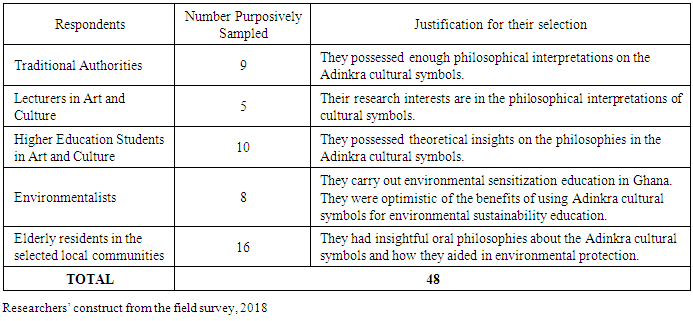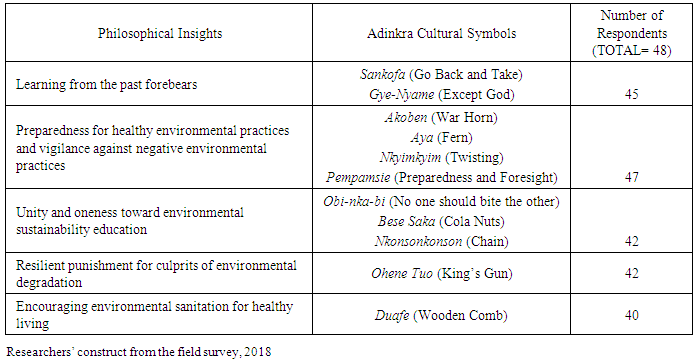-
Paper Information
- Paper Submission
-
Journal Information
- About This Journal
- Editorial Board
- Current Issue
- Archive
- Author Guidelines
- Contact Us
World Environment
p-ISSN: 2163-1573 e-ISSN: 2163-1581
2018; 8(2): 36-46
doi:10.5923/j.env.20180802.02

Adinkra Cultural Symbols for Environmental Sustainability Education in Ghana
Dickson Adom1, Moses Opoku2, Jerry Pratt Newton3, Akwasi Yeboah4
1Department of Educational Innovations in Science and Technology, Kwame Nkrumah University of Science and Technology, Kumasi, Ghana
2Department of Fine Arts and Design, University of Port Harcourt, Port Harcourt, Nigeria
3Department of Education, Institute of Distance Learning, Kwame Nkrumah University of Science and Technology, Kumasi, Ghana
4Berekum College of Education, Brekum, Brong Ahafo Region, Ghana
Correspondence to: Dickson Adom, Department of Educational Innovations in Science and Technology, Kwame Nkrumah University of Science and Technology, Kumasi, Ghana.
| Email: |  |
Copyright © 2018 The Author(s). Published by Scientific & Academic Publishing.
This work is licensed under the Creative Commons Attribution International License (CC BY).
http://creativecommons.org/licenses/by/4.0/

The Adinkra symbols are one of the ancient philosophical marvels of creation by the indigenous Ghanaians. Aside from their excellent design concepts, they are also latent with unparalleled philosophical thoughts. The main thrust of the paper was to investigate into the possibility of using the philosophical ideologies enshrined in the Adinkra symbols for educating the Ghanaian people about environmental sustainability. The study was rooted in the qualitative research approach with descriptive method guiding every facet of the research. Interviews and observations were the main data instrumentations for the study. A total of forty eight respondents consisting of five lecturers, ten students, sixteen elderly residents, nine traditional authorities as well as eight environmentalists who were purposively sampled were involved in the study. The study unearths the philosophical meanings of some of the Adinkra symbols in resonance with the preservation and sustainable use of the environment and its resources. The study concludes that the Adinkra cultural symbols of Ghanaians have rich philosophies that can be tailored to promote and sensitize the general public on the relevance of environmental sustainability. It recommends that the government, ministries and agencies responsible for environmental sustainability awareness programs and campaigns must utilize the Adinkra symbols to enhance environmental sustainability education in Ghana.
Keywords: Adinkra Symbols, Culture, Environmental Sustainability Education, Philosophy, Environmental Protection
Cite this paper: Dickson Adom, Moses Opoku, Jerry Pratt Newton, Akwasi Yeboah, Adinkra Cultural Symbols for Environmental Sustainability Education in Ghana, World Environment, Vol. 8 No. 2, 2018, pp. 36-46. doi: 10.5923/j.env.20180802.02.
Article Outline
1. Introduction
- Environmental sustainability education stresses on assisting and engaging individuals and groups to understand the natural systems and environmental issues (Iyer-Raniga & Andamon, 2013). It is aimed at motivating persons of all ages in living sustainable lifestyles, especially towards the environment and its resources (Sund & Lysgaard, 2013). The ultimate goal is to effect positive change in the attitudes of individuals towards caring for the environment and its resources (Ardoin & Ryan, 2011). However, the education on environmental sustainability extends beyond transforming attitudes to the change in the mental dispositions where decisions on the actions toward the environment issue from (Sustainable Development Education Panel, 1999). The path of environmental sustainability education dwells more on the humanistic concept that focuses on the views and cultures of people (Mandikonza & Latz-Sisitka, 2016) with less emphasis on finding solutions to environmental problems in science and technology (UNESCO, 1997). The humanistic concept involves educating people to live in harmony with nature while cultivating good traits such as respect, selflessness, social justice and tolerance (UNESCO, 2015). This form of education that looks into the perceptions of people is rooted in the cultural traditions of people. The informal instruments such as proverbs (Adom, 2016), myths, folklores, taboos used for instructing societal members to cultivate moral attitudes that propels them to live sustainable with nature and its resources (Asante, Adom & Arthur, 2017; Pretty, Adams, Berkes, Ferriera, Dudley, Hunn, Maffi, Milton, Rapport, Robbins, Sterling, Stotlin, Tsing, Vintinner & Pilgrim, 2009).Mapira and Mazambara (2013) as cited in Adom, Kquofi and Asante (2016) indicated that these cultural instruments for environmental sustainability in Africa were efficient means of curbing unwarranted behavioural attitudes toward the environment and its natural resources. The teaching aids for such environmental sustainability education were the cultural symbols understood by members of the Ghanaian society. Paramount among these cultural symbols are the Adinkra symbols. The Adinkra symbols are special symbols with symbolic and philosophical meanings stamped in mourning cloths to bid farewell to the dead (Adom, 2009; Adom, 2014). The adinkra symbols are laden with philosophical ideals that offer deep understanding into the values, norms and beliefs of the Ghanaian people (Adom, 2016). They offer insightful information for meditation on the need to demonstrate good behavioural attitudes. Many of the Adinkra cultural symbols are keen for environmental sustainability education because as an important feature of this form of education, it must be locally relevant and culturally appropriate for the people (Sustainable Development Education Panel, 1999). Ghanaians take great pride in the Adinkra symbols. The symbols have been used singlehandedly in many scenarios to represent the splendid Ghanaian cultural heritage (Adom, Asante & Kquofi, 2016). However, there is no study that has sought to find the links between the Adinkra symbols and environmental sustainability education. Therefore, the main tenet of the study was to investigate into the Adinkra cultural symbols to find out their philosophical insights that can be used for environmental sustainability education in Ghana. The study was hinged on these two research questions:1. Which of the Adinkra cultural symbols have philosophical insights for environmental protection and could be used for environmental sustainability education?2. How can the identified Adinkra cultural symbols be used as an instructional tool for environmental sustainability education?The research is relevant because it supports the culture theory by Milton (1996) that the culture of a people holds insightful benefits that can improve the state of societies. The environmental sustainability education also aims at changing the mindset of individuals and their conduct and perceptions of the environment (Sund & Lysgaard, 2013). This is seen as being a powerful weapon in positively regulating the attitudes of people toward the sustainable use of the environment and its resources. Ghana as a country has now adopted the human ecology approach (Ghana NBSAP, 2016) to natural resource and environmental protection. Therefore, the study has cleverly adopted the adinkra cultural symbols that are well embraced by the Ghanaian people as part of their cherished cultural heritage, and imbued it with philosophical imports that can be used for environmental sustainability education.
2. Methodology
- The qualitative research design was utilized for the study due to its social-cultural nature (Denzin & Lincoln, 1994). Another key reason why the researchers utilized the qualitative design was also because they wanted to find out how the respondents understood the philosophical imports of the Adinkra symbols in relation to environmental sustainability education (Creswell, 2009). The researchers wanted to creatively explore how the Adinkra cultural symbols could be used for carrying out environmental sustainability education through observation and description, hence the use of the descriptive research method (Koh & Owen, 2008). This was overachingly aimed at discovering new knowledge (The Association of Educational Communications and Technology, 2001) about the Adinkra symbols and the roles they can play in environmental sustainability education.The rich data for the study was gathered via two main anthropological data collecting instruments, interviews and observation. Personal interviews and Focus Group Discussions were carried out by the researchers in ascertaining the philosophical understanding of respondents on how the well-known Adinkra symbols could be used in heigthening environmental sustainability education through an interactive communication (Moriarty, 2011) between the researchers and the respondents. The interviews were highly in a semi-structured form. This form of interview with its distinctive flexibility (Kumekpor, 2002) allowed the researchers the freedom to ask the main questions with other auxiliary questions to solicit for the hidden and detailed views of respondents on the Adinkra symbols. Also, the researchers keenly observed how the Adinkra cultural symbols were used in the three local communities whose traditional authorities were involved in the study. The observations assisted the researchers in offering a ‘written photograph’ (Erlandson, Harris, Skipper & Allen, 1993) of the relevance of the Adinkra symbols for instructing members in the Ghanaian local communities on positive moral behaviours.The forty eight respondents involved in the study (Table 1) were purposively selected because they possessed distinctive features that greatly assisted in realizing the objectives of the study (Fraenkel, Wallen & Hyun, 2012). Nine traditional authorities and sixteen elderly residents who were seen as well versed in the cultural traditions and symbolic meanings associated with the Adinkra cultural symbols in three local communities in Ghana, namely, Buoyem, Anyinam-Kokofu and Kumawu were engaged in the study. Eight environmentalists working in the Environmental Protection Agency and the Resource Management Support Centre of the Forestry Commission were also purposely selected for the study. This was due to the personal beliefs they held that the Adinkra cultural symbols were of great value in environmental sustainability education. Also, five lecturers and ten students in Art and Culture in the Kwame Nkrumah University of Science and Technology and the University of Education, Winneba of Ghana were deliberately selected for the study. They were selected by the researchers based on prior background information that their research interests were directly linked to the use of cultural symbols for societal development.
|
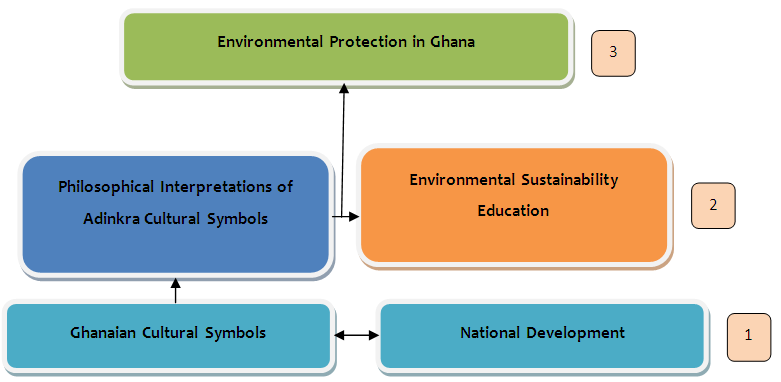 | Figure 1. The Conceptual Framework for the Study (Source: Researchers’ Construct) |
3. Results and Discussions
- The findings from the study are presented and discussed under the two main headings, namely: the identification and description of Adinkra cultural symbols with philosophical insights for environmental sustainability education, and the suggested ways that the identified and described Adinkra cultural symbols can be used as instructional materials for environmental sustainability education.
3.1. Adinkra Cultural Symbols with Philosophical Insights for Environmental Sustainability Education
- Through the interviews and observations, the researchers gathered various Adinkra symbols that were opined by the respondents as having philosophical insights that could be used for environmental sustainability education in Ghana. A total of fifteen (15) Adinkra cultural symbols were identifies as having philosophical insights on environmental protection and could be used for environmental sustainability education. They included the Sankofa, Nkyimkyim, Gye Nyame, Bese Saka, Pempamsie, Ohene Tuo, Obi Nka bi, Aya, Duafe, Nkonsonkonson, Akoben, Fihankra, Sunsum and others. It was noticed among the traditional authorities and the residents in the selected local communities that they knew more of the original symbolic interpretations of the Adinkra cultural symbols. However, when they were helped to reason in relation to how the Adinkra cultural symbols could be used for environmental sustainability education, they offered very interesting remarks. For instance, all the traditional authorities interviewed separately in private interviews, surprisingly mentioned the Sankofa Adinkra symbol as the most important of all the Adinkra symbols in relation to environmental sustainability education. They all shared common philosophical interpretations of the symbol. The comments made by the traditional chief of Buoyem resonated with the other traditional authorities that:The Sankofa Adinkra cultural symbol is a reminder to society members to follow the sustainable lifestyles of their early forebears. They always thought of the future generations and censored the use of the environment and its resources. They were determined to please the spirits and deities whom they believed would bless them for living sustainable lifestyles. The symbol educates society members in modern local communities to walk the ethically appropriate paths of their ancestors, by caring for the environment and engaging in healthy environmental practices (TA-Buoyem, Personal Communication, 2/12/2017).On the other hand, the lecturers and students knowledgeable in culture were forthright in explaining the philosophical values in the Adinkra cultural symbols. Many of them highlighted the Adinkra symbols that emphasized on having peaceful relations with one another, including all living and non-living things in the physical and spiritual environments as well as unity in fighting towards the goal of environmental sustainability. The notable Adinkra cultural symbols mentioned by a larger section of them were the Obi-nka-bi and Nkonsonkonson. The lecturers disclosed that achieving environmental protection and sustainability requires a concerted efforts of all societal members. The same sentiments were expressed by the students in the Focus Group Discussions. The lecturers in culture said:The environment and its resources are the inheritance of all the members in the society. If we care for it well, all of us would benefit from it immeasurably. On the other hand, if we wantonly destroy it, natural reprisals from our negative actions would befall all of us. That is the philosophy in the Obi-nka-bi Adinkra cultural symbol that we need to come together as a team to stand up against all negative activities like illegal mining, deforestation and so forth. We must equally forge a team in engaging in healthy environmental practices (LT-UEW, Personal Communication, 2/12/2017).The students also remarked:We must join hands in this environmental sustainability education in all the Ghanaian societies. The main philosophical thread in the Nkonsonkon is that it is in unity that we find the strength to fight for the rights of existence of all living and non-living things. We must take everyone on board before we can succeed in our efforts to save the environment and ensure the pepertual supply of its goodness to society (ST-KNUST, Personal Communication, 21/11/2017).The environmentalists were much concerned with the recent natural reprisals such as flooding, hurricanes, storm and so forth that keeps plaguing many countries globally in these modern times. They emphasized the Adinkra cultural symbols such as the Akoben and Pempamsie that educates on the need to prepare our environments so that they can protect us from any unexpected natural reprisals by encouraging the engagement in healthy environmental practices while shunning negative environmental practices. In a Focus Group Disucssion with the environmentalists, they said:Our preparedness now will save us of all future natural reprisals. We keep on seeing the untold hardships happening to other countries sue to their lack of preparedness towards some of these unfortunate but sad realities. We need to constantly alert our society members the great benefits of planting trees now, mapping up a collective effort against all negative environmental activities, and so forth. The Akoben and Pempamsie Adinkra cultural symbols educate us that we must always engage in positive environmental activities to prepare ourselves not only to cushion us for any unexpected natural reprisal, but more importantly, to save the environment for our present and future use (ENV-EPA, Personal Communication, 11/10/2017).Figure 2 shows a graphical representation of the views of respondents in relation to the identified Adinkra cultural symbols for environmental sustainability education and the percentages of the areas of priority in their philosophical insights. Also, Table 2 shows the philosophical insights of respondents on the identified Adinkra cultural symbols for environmental sustainability education in Ghana.
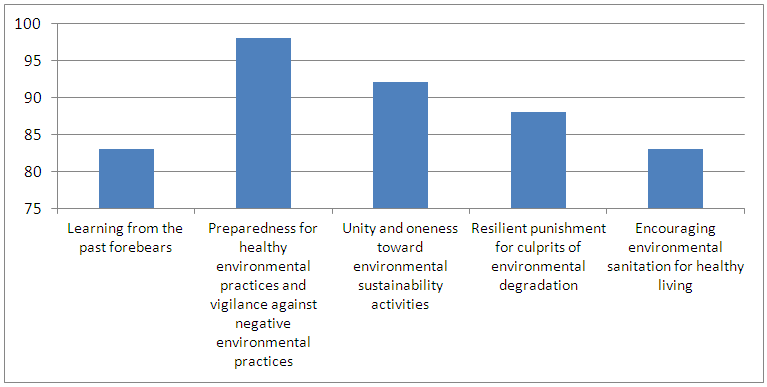 | Figure 2. The Views of Respondents on the Philosophical Insights in the Adinkra Cultural Symbols (Source: Researchers’ Construct) |
|
 | Figure 3. Sankofa Adinkra Symbol (Educates us of our roles as stewards of the environment and its associated acconuntability) |
 | Figure 4. Nkyimkyim Adinkra Symbol (Educates us on the need for society members to set good examples in protecting the environment and ensuring the sustainability of its resources) |
 | Figure 5. Gye Nyame Adinkra Symbol (Educates us of God’s Protection for those who protect and care for the environment) |
 | Figure 6. Bese Saka Adinkra Symbol (Educates us of the need to engage in a united efforts against all forms of unhealthy environmental activities) |
 | Figure 7. Pempasie Adinkra Symbol (Educates us on the importance of societal preparedness for the future through the engagement in environmental activities) |
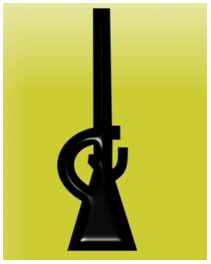 | Figure 8. Ohene Tuo Adinkra Symbol (Educates us that there is punishment for engaging in negative environmental activities) |
 | Figure 9. Obi nka bi Adinkra Symbol (Educatepeaceful co-existence between human beings and the environment) |
 | Figure 10. Aya Adinkra Symbol (Educate countries to be resourceful and self-reliant by judiciously using the environment and its resources) |
 | Figure 11. Duafe Adinkra Symbol (Educate countries to engage in sanitation and cleanliness exercises to improve the state of the environment) |
 | Figure 12. Nkonsonkonson Adinkra Symbol (Educate society members to demonstrate cooperativeness in engaging in environmentally friendly activities to improve the state of thbe enviornment) |
 | Figure 13. Akoben Adinkra Symbol (Educate society members to be loyal, alert, and ready to support all environmentally healthy activities organized in their respective communities) |
3.2. How the Identified and Described Adinkra Cultural Symbols could be Used as an Instructional Tool for Environmental Sustainability Education
- The researchers inquired from respondents the viable ways that the Adinkra cultural symbols could be used for environmental sustainability education in Ghana. The views from respondents varied greatly (Figure 14). However, they all suggested wide publicity avenues and tools. The lecturers, students and environmentalists suggested using educational platforms such as incorporating environmental sustainability education via cultural symbols into the school curriculum. The lecturers told the researchers:Targeting the educational institutions with the mandate to educate learners on environmental sustainability using the Adinkra cultural symbols. These informative cultural symbols must be incorporated into the Environmental Studies and Social Studies subjects taught in the Primary, Junior and Senior High schools in Ghana (LT-KNUST, Personal Communication, 14/12/2017).The respondents suggested the appointment of knowledgeable edlers as resource persons to schools to assist teachers in carrying out the environmental sustainability education. At the higher education level, a greater section of the respondents suggested the organization of seminars, workshops and talk shows for higher education students. In a Focus Group Discussion, the students suggested that:
 | Figure 14. Suggested Ways for Using Adinkra Cultural Symbols for Environmental Sustainability Education (Source: Source: Researchers’ Construct) |
4. Conclusions
- The study was aimed at investigating the Adinkra cultural symbols that could be used for environmental sustainability education in Ghana due to the high impacts of culture in the Ghanaian community. Also, it was finally to suggest proactive ways of utilizing the identified Adinkra cultural symbols as instructional tools for environmental sustainability education in Ghana. Though the study revealed that numerous Adinkra cultural symbols had philosophical values that could be used for environmental sustainability education, eleven (11) Adinkra cultural symbols have been discussed thoroughly. The philosophical insights from the Adinkra cultural symbols included learning from the past forebears [Sankofa (Go Back and Take), Gye-Nyame (Except God)], preparedness for healthy environmental practices and vigilance against negative environmental practices [Akoben (War Horn), Aya (Fern), Nkyimkyim (Twisting), Pempamsie (Preparedness and Foresight)], unity and oneness toward environmental sustainability activities [Obi-nka-bi (No one should bite the other), Bese Saka (Cola Nuts), Nkonsonkonson (Chain)], resilient punishment for culprits of environmental degradation [Ohene Tuo (King’s Gun)] and encouraging environmental sanitation for healthy living [Duafe (Wooden Comb)]. It was suggested that the use of educational programs, visual communication media, mass media, and the school curriculum are viable platforms to educate the members in the Ghanaian society on environmental sustainability from the philosophical imports of the Adinkra cultural symbols. The research is tasking environmental agencies to collaborate with cultural experts so that the Adinkra cultural symbols could be used to maximize environmental sustainability education in Ghana.
ACKNOWLEDGEMENTS
- The researchers thank sincerely, the traditional authorities and the elderly residents in Buoyem, Anyinam-Kokofu and Kumawu as well as the environmentalists and conservationists in the Emnvironmental Protection Agency and the Resource Management Support Centre of the Forestry Commission all in the Ashanti Region of Ghana for supporting the research.
 Abstract
Abstract Reference
Reference Full-Text PDF
Full-Text PDF Full-text HTML
Full-text HTML